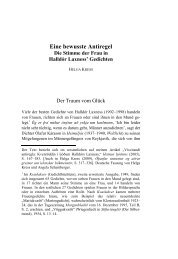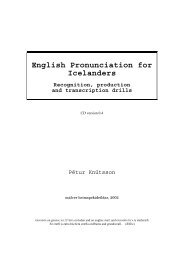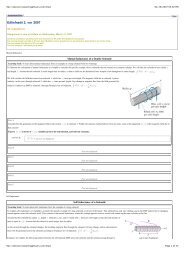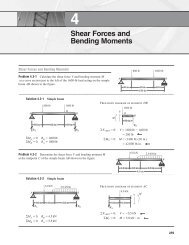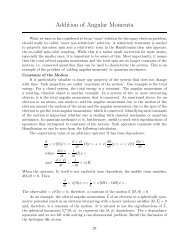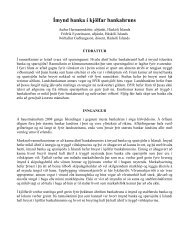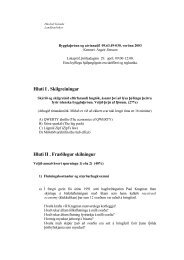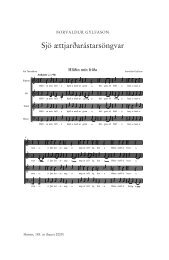The Hartree-Fock approximation underlies the most commonly used ...
The Hartree-Fock approximation underlies the most commonly used ...
The Hartree-Fock approximation underlies the most commonly used ...
You also want an ePaper? Increase the reach of your titles
YUMPU automatically turns print PDFs into web optimized ePapers that Google loves.
to find stationary points of L. That is, given infinitesimal change in <strong>the</strong> spin-orbitals,<br />
χa → χa + δχa, <strong>the</strong> change in L, (L → L + δL), should be zero, i.e.:<br />
0 = δL = δE0 −<br />
N<br />
a=1<br />
N<br />
b=1<br />
ǫba δ[a|b] .<br />
We now evaluate <strong>the</strong> terms on <strong>the</strong> right hand side of this expression. By inserting <strong>the</strong><br />
new spin-orbitals χa + δχa, etc. into <strong>the</strong> expression for E0, and using <strong>the</strong> fact that <strong>the</strong><br />
integration indicated by [ ] is a linear operation, <strong>the</strong> change in E0 is to first order:<br />
δE0 =<br />
+ 1<br />
2<br />
N<br />
a=1<br />
([δχa|h|χa] + [χa|h|δχa])<br />
N<br />
a=1<br />
N<br />
b=1<br />
<br />
[δχaχa|χbχb] + [χaδχa|χbχb] + [χaχa|δχbχb] + [χaχa|χbδχb]<br />
<br />
− [δχaχb|χbχa] − [χaδχb|χbχa] − [χaχb|δχbχa] − [χaχb|χbδχa] .<br />
From <strong>the</strong> definition of <strong>the</strong> integrals it is clear that [δχa|h|χa] ∗ = [χa|h|δχa] and [δχaχa|χbχb] ∗ =<br />
[χaδχa|χbχb], etc. Fur<strong>the</strong>rmore, [δχaχa|χbχb] = [χbχb|δχaχa] as can be seen by relabeling<br />
<strong>the</strong> integration variables representing <strong>the</strong> electron coordinates. <strong>The</strong> change in E0 can<br />
<strong>the</strong>refore be rewritten as:<br />
δE0 =<br />
N<br />
[δχa|h|χa] +<br />
a=1<br />
N<br />
a=1<br />
N<br />
[δχaχa|χbχb] − [δχaχb|χbχa] + c.c.<br />
b=1<br />
<strong>The</strong> notation c.c. stands for complex conjugate.<br />
Using <strong>the</strong> factor rule of differentiation on <strong>the</strong> second term in <strong>the</strong> expression for δL<br />
gives<br />
ab<br />
δ[a|b] = δ[χa|χb] = [δχa|χb] + [χa|δχb]<br />
<br />
ǫbaδ[χa|χb] = <br />
ǫba[δχa|χb] + <br />
ǫba[χa|δχb] .<br />
ab<br />
Interchanging <strong>the</strong> summation indices a and b in <strong>the</strong> second sum on <strong>the</strong> right hand side<br />
gives: <br />
ǫbaδ[χa|χb] = <br />
ǫba[δχa|χb] + <br />
ǫab[χb|δχa] .<br />
ab<br />
ab<br />
L is a real quantity and by taking <strong>the</strong> complex conjugate of <strong>the</strong> expression defining L, it<br />
can be shown that ǫba = ǫ∗ ab , that is <strong>the</strong> Lagrange multipliers are elements of a Hermitian<br />
matrix. This means <strong>the</strong> second sum is just <strong>the</strong> complex conjugate of <strong>the</strong> first, and we have<br />
<br />
ab<br />
ǫbaδ[χa|χb] = <br />
ab<br />
34<br />
ab<br />
ab<br />
ǫba[δχa|χb] + c.c..



